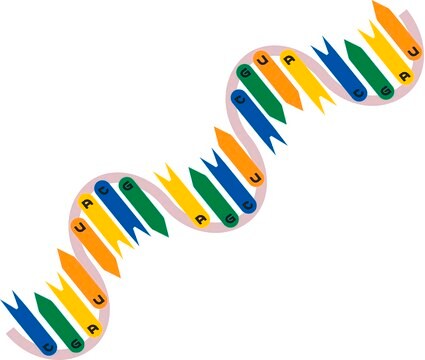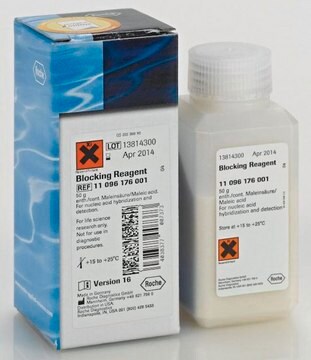R7009
Sty I from Escherichia coli strain carrying pST27
buffered aqueous glycerol solution
Sign Into View Organizational & Contract Pricing
All Photos(1)
About This Item
CAS Number:
MDL number:
UNSPSC Code:
12352204
NACRES:
NA.53
Recommended Products
form
buffered aqueous glycerol solution
concentration
10,000 units/mL
shipped in
wet ice
storage temp.
−20°C
Specificity
Recognition sequence: 5′-C/C(A,T)(T,A)GG-3′
Ligation and recutting results: After 2-10-fold Sty I overdigestion of 1 μg λ DNA substrate, results in 100% cutting, >95% of fragments can be ligated, and >95% recut.
Heat inactivation: Inactivated at 65 °C for 15 minutes.
Ligation and recutting results: After 2-10-fold Sty I overdigestion of 1 μg λ DNA substrate, results in 100% cutting, >95% of fragments can be ligated, and >95% recut.
Heat inactivation: Inactivated at 65 °C for 15 minutes.
Other Notes
Supplied with 10x Restriction Endonuclease Buffer SH (B3657).
Physical form
Solution in 20 mM Tris-HCl, pH 7.5, 0.1 mM EDTA, 50 mM KCl, 10 mM 2-mercaptoethanol, 0.1% gelatine (v/v), 0.01% polydocanol (v/v), 50% glycerol (v/v) at 4 °C
Choose from one of the most recent versions:
Already Own This Product?
Find documentation for the products that you have recently purchased in the Document Library.
K Mise et al.
Gene, 33(3), 357-361 (1985-01-01)
A new restriction endonuclease, StyI, free of contaminating nuclease activities, has been isolated from Escherichia coli carrying the hsd+ miniplasmid of Salmonella typhi origin. In the presence of 10 mM Mg2+, it recognizes and cleaves a hexanucleotide sequence of 5'-C
C Kessler et al.
Gene, 47(1), 1-153 (1986-01-01)
The properties and sources of all known restriction endonucleases and methylases are listed. The enzymes are cross-indexed (Table I), classified according to their recognition sequence homologies (Table II), and characterized within Table II by the cleavage and methylation positions, the
Cong Zhu et al.
Nucleic acids research, 41(4), 2455-2465 (2013-01-11)
Zinc-finger nucleases (ZFNs) have been used for genome engineering in a wide variety of organisms; however, it remains challenging to design effective ZFNs for many genomic sequences using publicly available zinc-finger modules. This limitation is in part because of potential
Annabel A Ferguson et al.
Methods in molecular biology (Clifton, N.J.), 940, 87-102 (2012-10-30)
The generation of transgenic animals is an essential part of research in Caenorhabditis elegans. One technique for the generation of these animals is biolistic bombardment involving the use of DNA-coated microparticles. To facilitate the identification of transgenic animals within a
TALENs and ZFNs are associated with different mutation signatures.
Yongsub Kim et al.
Nature methods, 10(3), 185-185 (2013-02-12)
Our team of scientists has experience in all areas of research including Life Science, Material Science, Chemical Synthesis, Chromatography, Analytical and many others.
Contact Technical Service






